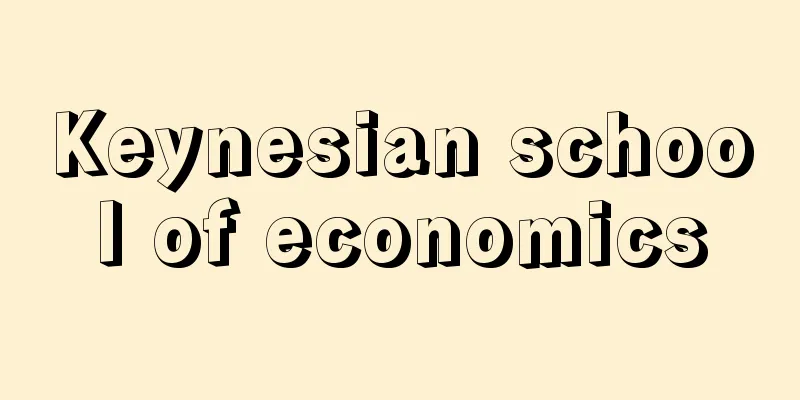Keynesian school of economics

|
This is one of the economic schools of thought that was strongly influenced by J.M. Keynes's The General Theory of Employment, Interest, and Money (1936). In terms of policy, it emphasizes the need for government aggregate demand management in the macroeconomy. As symbolized by P.A. Samuelson's Neoclassical Synthesis, it also includes those that take the neoclassical position of emphasizing the efficient resource allocation function of the price mechanism in the long term, but also preach the need for short-term aggregate demand management measures (fiscal and monetary policies). It is in this policy dimension that people are talking about the revival of Keynes as a way to deal with the 2008 financial crisis that began in the United States (which former FRB Chairman Alan Greenspan called a once-in-a-century credit tsunami). In recent years, this name has rarely been used, but it had a more strict theoretical meaning. There is no complete agreement on what the theoretical core of Keynesian economics is, but it is generally thought to be as follows: the accumulation of micro actions does not become macro actions, and conversely, macro cannot be reduced to its micro parts (the existence of the so-called fallacy of composition); what drives the economy is the principle of effective demand (companies predict uncertain demand for the economy and produce at a level that maximizes their profits), and therefore production at a full employment level is not always guaranteed (denial of Say's law); in the real world, the real world and the monetary world cannot be separated, and money plays an important role in the economy (denial of the Bail view of money and the quantity theory of money. Monetarists' claim that "money is important" merely asserts the relationship between the quantity of money and prices), etc. It is in this context that the expansion of speculative activity is said to be in danger of destabilizing the economy. However, Keynes's economics, which was even called the "Keynesian Revolution" (a term coined by L.R. Klein), did not necessarily renew old economics, and as a result, what was widely circulated as Keynes's economics was J.R. Hicks' IS-LM interpretation of Keynes, which treated Keynes's ideas as a specific theory and A. Marshall's ideas, whom Keynes criticized, as a general theory. As can be seen from the representative introductory textbooks on economics from around the 1950s to the present day, such as those by Samuelson, G. Mankiw, G. E. Stiglitz, and P. R. Krugman, there is a view that Keynesian economics has already been subsumed into mainstream neoclassical economics, while many researchers do not accept this claim and have developed in various directions, such as growth theory and structural dynamics theory, based on the main elements of Keynes as mentioned above. The points of contention are wide-ranging, and there are differences of opinion and conflicts within groups on details, such as whether it is possible to build a theory assuming the existence of long-term equilibrium and whether the money supply is exogenous or endogenous. However, in addition to Keynesians in the narrow sense, researchers who distinguish themselves from neoclassical economics, such as those influenced by the institutional school and Marxist economics, are often collectively referred to as post-Keynesians today. Representative Keynesians in the narrow sense include R. Cahn, J. Robinson, N. Kaldor, L.L. Pasinetti, P. Sraffa, G.L.S. Shackle, G.C. Harcourt, and T. Lawson in the economics group centered around Cambridge in the UK, S. Weintraub, H. Minsky, R.M. Goodwin, and P. Davidson in the US, and Miyazaki Yoshikazu, Ito Mitsuharu, Asano Eiichi, and Hishiyama Izumi in Japan. [Yuichiro Otsuka] "Heretical Economics" by J. V. Robinson, translated by Hirofumi Uzawa (1973, Nihon Keizai Shimbun) " ▽ "Structural Change and Economic Growth" by L. L. Pasinetti, translated by Yuichiro Otsuka and Katsuyoshi Tokai (1983, Nihon Hyoronsha)" ▽ "The General Theory: Second Edition, edited by G. C. Harcourt and P. A. Leack, translated by Shozo Koyama (2005, Taga Publishing)" [References] | | | | | | | | | | | | | |Source: Shogakukan Encyclopedia Nipponica About Encyclopedia Nipponica Information | Legend |
|
J・M・ケインズの『雇用・利子および貨幣の一般理論』(1936)の影響を強く受けた経済学派の一つ。政策論的にはマクロ経済における政府の総需要管理の必要性を強調する。P・A・サミュエルソンの新古典派総合に象徴されるように、長期的には価格メカニズムによる効率的な資源配分機能を強調する新古典派の立場をとりながらも短期的な総需要管理策(財政金融政策)の必要を説くものも含まれる。2008年のアメリカ発の金融危機(グリーンスパン前FRB(連邦準備制度理事会)議長によれば100年に一度の信用津波)への対処法としてケインズの復活がうんぬんされるのは、このような政策の次元での話である。 近年この名称が用いられることはほとんどなくなったが、それは理論的にはもっと厳密な意味をもつものであった。ケインズ経済学の理論的核心が何かについては意見の完全な一致があるわけではないが、おおむね次のようなものであると思われる。ミクロの行動の積み上げがマクロの行動になるわけではなく、逆にマクロをミクロの部分に還元することはできないこと(いわゆる合成の誤謬(ごびゅう)の存在)、経済を動かすものは有効需要の原理(企業は経済について不確実な需要を予想し、そのなかで自らの利益を最大にするような水準で生産を行う)であること、したがって完全雇用水準での生産がいつも保証されるわけではないこと(セーの法則の否定)、現実の世界では実物世界と貨幣世界を切り離すことはできず、貨幣が経済において重要な働きをしていること(貨幣ベール観・貨幣数量説の否定。マネタリストの「貨幣が重要である」との主張は貨幣数量と物価との関連を主張しているにすぎない)などである。投機活動の膨張が経済の不安定化をもたらす危険があるとされるのはこの文脈においてである。しかし、「ケインズ革命」(L・R・クラインによる命名)とまでいわれたケインズの経済学はかならずしも古い経済学を一新したものとはならず、そのため、ケインズの経済学として広く流布したのは、ケインズの考えを特殊理論とし、ケインズが批判の対象としたA・マーシャルの考えを一般論とするJ・R・ヒックスのIS‐LM論的ケインズ解釈であった。 1950年代ごろから今日に至る代表的な経済学の入門書、たとえば、サミュエルソンやG・マンキュー、G・E・スティグリッツ、P・R・クルーグマンなどの教科書をみればわかるように、ケインズの経済学はすでに主流派の新古典派経済学に包摂されたとする考えがある一方、そうした主張を認めず、上述したようなケインズの主要な要素をもとに成長理論や構造動学理論など、さまざまな方向へ展開を行っている研究者も多い。それらの論点は多岐にわたり、なかには長期的均衡の存在を想定しての理論構築の可否や貨幣供給は外生的か内生的かなど、その細部においてグループ内での意見の相違・対立もないわけではないが、現在ではこれらの狭義のケインジアンのほか、制度学派やマルクス経済学の影響を受けた研究者など、新古典派経済学と一線を画すものを総称してポスト・ケインズ派とよぶことが多い。代表的な狭義のケインジアンとしては、イギリス・ケンブリッジを中心とした経済学グループではR・カーン、J・ロビンソン、N・カルドア、L・L・パシネッティ、P・スラッファ、G・L・S・シャックル、G・C・ハーコート、T・ローソンらが、アメリカではS・ワイントラウプ、H・ミンスキー、R・M・グッドウィン、P・デービッドソンらが、日本においては宮崎義一(よしかず)、伊東光晴(みつはる)、浅野栄一、菱山泉(ひしやまいずみ)らがあげられる。 [大塚勇一郎] 『J・V・ロビンソン著、宇沢弘文訳『異端の経済学』(1973・日本経済新聞社)』▽『L・L・パシネッティ著、大塚勇一郎・渡会勝義訳『構造変化と経済成長』(1983・日本評論社)』▽『G・C・ハーコート、P・A・リーアック編、小山庄三訳『一般理論―第二版』(2005・多賀出版)』 [参照項目] | | | | | | | | | | | | | |出典 小学館 日本大百科全書(ニッポニカ)日本大百科全書(ニッポニカ)について 情報 | 凡例 |
Recommend
Aware - Pity
...Instruments used include the shakubyoshi playe...
Valse
...This form was refined by Lanner and Johann Str...
Praise of Folly - Chigushinraisan
A book by Erasmus. Original title Moriae encomium,...
Pothos (English name) Epipremnum aureum
It is a climbing herb of the Araceae family, and i...
Conference - Kaiten
A comprehensive administrative code from the Ming ...
Crinum moorei (English spelling)
…[Tora Saburo Kawabata]. … *Some of the terminolo...
.
...refers to the inability to have a live birth e...
Takasu [town] - Takasu
A town in Kamikawa County, located in central Hokk...
Minase Shrine
A shrine located in Hirose, Shimamoto-cho, Mishima...
Futaba Nursery School - Futaba Nursery School
A representative nursery school founded in the Mei...
Capital Intensity
This refers to the amount of capital per employed...
Wood, J. (Jr.)
…These British Palladian architects, father and s...
Pressurized non-catalytic partial oxidation method
… Naphtha was once widely used as the raw materia...
al-Sham (English spelling)
…the historical name for the long, narrow strip o...
Dog hunting - Inuryou
…Until 1787, under Louis XVI, the Danish kings pr...








![Senmaya [town] - Senmaya](/upload/images/67cc0bea6d905.webp)
